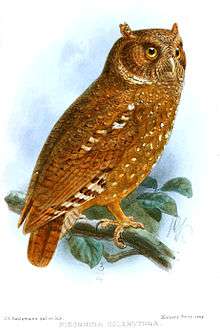Sandy scops owl
The sandy scops owl (Otus icterorhynchus), or cinnamon scops owl, is an owl from the family Strigidae found in Africa.
| Sandy scops owl | |
|---|---|
 | |
| An illustration of the holerythrus subspecies. | |
| Scientific classification | |
| Kingdom: | Animalia |
| Phylum: | Chordata |
| Class: | Aves |
| Order: | Strigiformes |
| Family: | Strigidae |
| Genus: | Otus |
| Species: | O. icterorhynchus |
| Binomial name | |
| Otus icterorhynchus (Shelley, 1873) | |
Description
A small owl which has an overall pale rufous colour, a plain face, a pale yellow bill and yellow eyes. The pale stripe along the shoulders is quite obvious. The adults are pale rufous brown, finely spotted with white and barred with buff. The underparts are paler and more rufous with buff bars and white spots on the belly and vent. The tailail, flight feathers and greater upperwing coverts are rufous barred with black. Length is about 15 centimetres (5.9 in), wingspan is 45 cm (18 in).[2]
Voice
The sound is a long whistling "twooo" which descends in pitch.[2]
Distribution and habitat
The sandy scops owl has a scattered distribution across the African tropical rainforest ; it has been recorded from Guinea, Liberia, Ivory Coast, Ghana, Cameroon, Gabon, Congo, Democratic Republic of Congo and Central African Republic.[1]
The sandy scops owl occurs in lowland evergreen forest, open canopy forest and scrub, or in open forest mosaic land.[3]
Habits
The sandy scops owl is rarely seen and little is known about its habits. It is probably crepuscular and insectivorous[3] feeding largely grasshoppers and crickets. The breeding is probably from in February–March.[1]
Subspecies
Two subspecies are currently recognised.[4]
- Otus icterorhynchus icterorhynchus: West Africa
- Otus icterorhynchus holerythrus: northern west central Africa.
Taxonomy
The sandy scops owl is thought to be basal in the lineage of the genus Otus, along with the Sokoke scops owl Otus ireneae, but there has been no genetic material for testing from the sandy scops owl.[5] In addition some authorities consider that the subspecies of sandy scops owl should be treated as two different species.[6]
References
- "Otis icterorhynchus". IUCN Red List of Threatened Species. Retrieved 27 October 2016.
- Kemp, Alan; Kemp, Meg (1998). Birds of Prey of Africa and its Islands. New Holland. pp. 314–315. ISBN 1-85974-100-2.
- "Profile Sandy Scops Owl". Avibirds.Owls. Avibirds. Retrieved 28 October 2016.
- "Sandy Scops-Owl Otus icterorhynchus (Shelley, 1873)". Avibase. Denis Lepage. Retrieved 28 October 2016.
- Fuchs, Jérôme; et al. (2008). "Tracing the colonization history of the Indian Ocean scops-owls (Strigiformes: Otus) with further insight into the spatio-temporal origin of the Malagasy avifauna". BMC Evolutionary Biology. 8: 197. doi:10.1186/1471-2148-8-197. PMC 2483963. PMID 18611281.
- "Sandy Scops-owl (Otus icterorhynchus)". Handbook of the birds of the World Alive. Lynx Edicions. Retrieved 28 October 2016.
